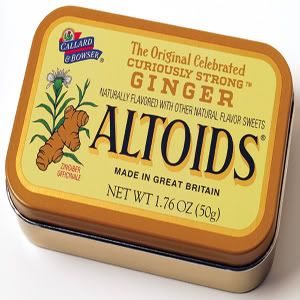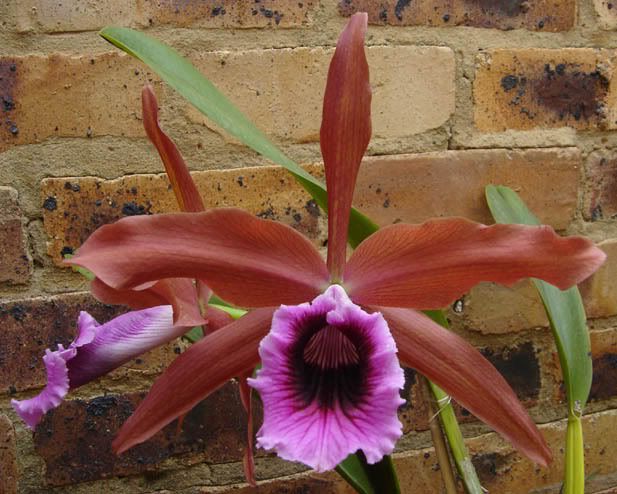That's it. A full year of greenhouse delights have come and gone. Consider this the final In The Greenhouse post for now. There's just no point in posting pictures of flowers you've seen before. As soon as novel beauties come into bloom, naturally I'll be sure to post those. And of course, you can always dip into the Archives and revisit old favourites! Thanks for all your enthusiasm; it's been a pleasure sharing a year's worth of irrational passion in this way. I hope you've been inspired by the world of orchids to add some tropical splendour to your own life.
Laelia tenebrosa. Big, colourful, bold as brass (literally). The flowers measure 18 cm from petal tip to petal tip. It's a summer-flowering Brazilian species and so always flowers around Chrimbo time in the southern hemisphere. Merry Christmas.
17 December 2006
An ode to zingerone
 Ginger. Where else would you find a flavour so common-place and familiar, so comfortingly domestic: our house filled with the tempting scent of my mother’s ginger snaps cooling in the kitchen; the deceptively light ginger beer we used to make during the summer school holidays; Mrs SJE de Villiers’s ginger waffles. Ginger. Where else would you find a flavour so exotically tropical, so wonderfully dangerous, so intertwined with tales of adventure in foreign climes, with the enigmatic history of the Spice Route? Thai curry is nothing without the tang of freshly grated ginger, sushi is just fish pressed between some rice without the delightful pink arrangement of amazu shoga to cleanse and refresh the palate in between bites.
Ginger. Where else would you find a flavour so common-place and familiar, so comfortingly domestic: our house filled with the tempting scent of my mother’s ginger snaps cooling in the kitchen; the deceptively light ginger beer we used to make during the summer school holidays; Mrs SJE de Villiers’s ginger waffles. Ginger. Where else would you find a flavour so exotically tropical, so wonderfully dangerous, so intertwined with tales of adventure in foreign climes, with the enigmatic history of the Spice Route? Thai curry is nothing without the tang of freshly grated ginger, sushi is just fish pressed between some rice without the delightful pink arrangement of amazu shoga to cleanse and refresh the palate in between bites. Oh, how I long for a colonial home: trade winds kicking up sand outside the screen doors, the texture of damask table linen, ceiling fans uselessly circulating the oppressive heat, the sound of singing coming from the plantation and Ceylon tea served at exactly four o’clock in fine white china with – best of all – some golden pieces of crystallized ginger! Ginger. The essence of contradiction. A taste of latent ruin.
Ginger is the rhizome of Zingiber officinale. The word ‘ginger’ is derived from the Sanskrit word shringavera, which means ‘shaped like a deer’s antlers’. The Zingiberaceae family possesses other culinary delights: Curcuma longa is a closely related plant and the source of the spice turmeric. The hot, pungent molecule in ginger is called zingerone. A name suited to a forbidden aphrodisiac. Chemically, it looks a lot like capsaicin, the hot molecule found in chillies, but lacks the long hydrocarbon tail and a nitrogen atom. It fits pain receptors on the tongue. A sting of pleasure. The ginger rhizome holds a complex variety of related compounds, all differing just slightly from zingerone in the length of the chain replacing one of the hydrogen atoms of the terminal methyl group. The exact blend of this intricate set of aromatics depends on nutrients in the soil, the temperature, the availability of light and a myriad of other growing conditions, making each piece of ginger totally unique.
Common ginger has small white and maroon flowers, but many of the other 60 Zingiber species and many related plants in the Zingiberaceae family have curiously beautiful, sometimes almost orchid-like blossoms: check out Zingiber spectabile, Roscoea purpurea, Costus pulverulentus, Etlingera eliator, and Hedychium coccineum at your nearest tropical conservatory. I never cease to be inspired and enchanted by the versatility of ginger. Here are two very easy recipes I’ve come across in my infatuation with ginger, my zingerone addiction.
Gingered watermelon juice
500 g watermelon, peeled, de-seeded and roughly chopped
2 tsp ginger, freshly grated
Process ingredients in a blender or food processor for 2 minutes. Add 6 ice cubes and process until ice is crushed. Serve garnished with a thin wedge of watermelon.
Gingery lemon muffins
1/4 cup maragrine, room temperature
1/4 cup sugar
1 egg
2 tbsp ginger, peeled and coarsely chopped
2 tbsp grated lemon zest
1 tsp baking soda
1 1/2 cups plain, low-fat yoghurt or buttermilk
2 cups plain flour
Cream together margarine and sugar in a large bowl. Beat in egg. Add ginger and lemon zest. In a separate small bowl, stir baking soda into buttermilk; it will start to bubble and rise. Fold flour into ginger mixture one third at a time, alternating with buttermilk. When well blended, spoon into greased muffin pans. Bake in a preheated 190°C oven for 15-20 minutes, or until lightly browned.
7 December 2006
5 things to do before 2006 ends
1. Finish the damn thesis. Obviously. I'm so close... need to really work on the Discussion now.
2. Make a glass tile mosaic. This has become a December tradition.
3. Repot all of the neglected orchids which are now taking root outside their pots. I'm a bad mother, sniff.
4. Read something longer than 100 pages that does not concern photosynthesis, kinase signal transduction or UDP:glucosyltransferase enzymes.
5. Lose some weight. Hmmm. This one might prove problematic right before the season of honey-glazed everything.
2. Make a glass tile mosaic. This has become a December tradition.
3. Repot all of the neglected orchids which are now taking root outside their pots. I'm a bad mother, sniff.
4. Read something longer than 100 pages that does not concern photosynthesis, kinase signal transduction or UDP:glucosyltransferase enzymes.
5. Lose some weight. Hmmm. This one might prove problematic right before the season of honey-glazed everything.
Subscribe to:
Posts (Atom)

